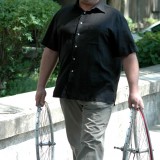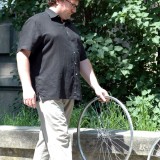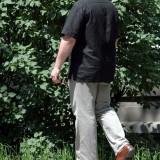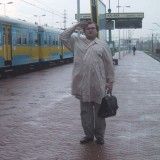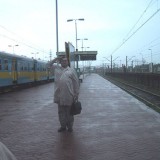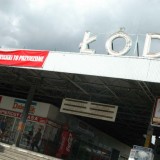Cezary Bodzianowski
To be an artist means to absorb. Absorb images, places, people, nature, objects and events. When the artist absorbs everything which he comes across, he/she reaches an interesting point. It may turn out that the point actually absorbs the artist together with his/her greediness. This place is called a Cave. In the cave the artist feels very decadent, sticky and thoughtless. No one leaves the Cave safe and sound and if one does, he/she is changed.
Cezary Bodzianowski, 2005.
Light-heartedness, carelessness, optimist and warm irony – these are for sure the first impressions one may have during contact with art actions by Cezary Bodzianowski, one of the most interesting artists not only in Łódź, but in Poland in general. Born in 1968 in Szczecin he is an artist and performer and a laureate of the Paszport Polityki award. From 1988-1990 studied painting at the Academy of Fine Arts in Warsaw, then between 1990-1994 in the Royal Academy of Fine Arts in Antwerp. He lives in Łódź and works together with his wife Monika Chojnicka, the author of the photo-and videodocumentation of his work.
He was initiallty fascinated with painting, “the structure of colour and light, the way colour changes with the time and surrounding space”. However, gradually he left sphere of painting and himself became the protagonist of his own art. He created a unique figure, a personality resembling the one from a story by the Swiss writer Robert Walser “Sunday walk”: “a few years ago I undertook, and it was in the summer, first longer hike, during which, as far as I remember, I saw various strange and beautiful things. My gear consisted of light, cheap clothes, navy blue hat on my head and a large bundle in my hand.”.
In similar clothing, which over time has become his identification, Bodzianowski walks around the world and with his discrete, or even kind interventions, paradoxically enters into a lot of daily commotion in the accepted ways of using an urban space, looking at objects, subjecting himself to rules and regulations. Bodzianowski once woke the inhabitants of one of the housing complexes in Łódź by knocking on the window from a fire-fighters’ lift. He took souvenir photos with pedestrians on zebra crossings, convoyed himself handcuffed and with a leather jacket on his head through the streets of the centre of the city, stood in front of the Museum in Toruń with a plastic bag filled with borrowed meteorites straight from outer space, where he was ignored by passers-by. In the Main Market Square in Kraków he walked among people for seven hours and with “cold blood” stared at selected women. He juggled with a hoola-hop like a champagne bubble against the background of a stem glass neon on the roof of the “Kaskada” in Łódź. Sometimes he dressed up: as a mushroom picker sitting at the road with empty baskets, as a prostitute or as a fat woman.
Since the 90s when he first appeared on the Polish artistic scene, he has done over 1000 such events – they are very simple, but slip out of analysis and artistic genres. Allegedly a meeting with a life coach helped him to discover this road: after coming back from abroad Bodzianowski was invited to participate in an exhibition, but it was not easy for him to admit that he doesn’t paint anymore and the idea of making a performance inside of the gallery during the opening wasn’t right for him. So facing a creative blockade, he decided to ask a specialist – a psychologist from Zgierz, who advised him to make an action in the “real space”. His personal theatre may also have its roots in his studies at the Academy in Warsaw, because then he also made his first actions in which the presence and consciousness of the artist was the main condition of the artwork to occur.
Since that time Bodzianowski has entered into the world as entering into a painting. We won’t see his traditional paintings anymore – even though during a recent exhibition in Brussels he tried to find them using a fortune teller. But his visual thinking can be seen in the composition of most actions and also in the documentation, in a non-accidental set f forms and colours, in the way details work. Because of the perfectly planned structure of the work and their relation to the space, they are also close to sculpture. References to the manual duties of an artist are invitations to subsequent actions which are artistic mini-objects, and objects which refer to the poetics of surrealism.
The object of action and interest of Cezary Bodzianowski is above all the urban space and private living spaces. Many actions take place in Łódź, a strange city which constantly provides inspirations for the artist, and also in the cities to which he travels to exhibit (Berlin Biennale, Bern, Tel Aviv, Paris). It’s the art, which deliberately slips out of the museum and gallery practice and often undertakes the problem of the place of art and artist within an institution. Bodzianowski keeps slipping out: he builds a ladder leading out of the gallery, tries to undergo conservation, visits museum magazines as a work of art, makes an action while standing in line waiting for the tickets to the impressionist exhibition, annoys museum security guards with his presence. More and more often he thinks of himself as an artist and moves threads connected with creating and the conditions that accompany being the transmitter of art. It was seen during the only exhibition which could be called his retrospective, entitled This place is called a Cave, presented in the Museum Abteiberg in Mönchengladbach and the Art Museum in Łódź which presented the most important issues in his art.
Although the activities by Cezary Bodzianowski seem to be “nice tales to console the souls tormented with an intellectual strain; hide-and-seek play, cheerful and lightly – only for good taste! – spiced with a pinch of melancholy” they have their depth, their dark cave within. Maybe it’s actually backwards: cheerfulness, joy and warm irony are the ways to deal with the experience of loss, which is the essence of the experience of melancholy.”
The longings, dreams and the attempts at impersonating someone, just for a while and moreover – knowing that one is not that impersonated character for sure, waiting for something to happen unnoticeably, meetings which are only possible in the space which emerges thanks to the perspective, are the basis of the majority of his actions. Under the apparent impression of lightness one may feel, that they are specific trials which the artist wants to heroically undertake.
Marta Skłodowska
The terms used In the text are taken from the writings of Robert Walser, and from the reviews of his books (Justyna Sobolewska, “Mistrz tańca”, www.polityka.pl; Łukasz Musiał and Arkadiusz Żychliński, “Znikający punkt. O Robercie Walserze”, Tygodnik Powszechny, www.tygodnik.onet.pl).


